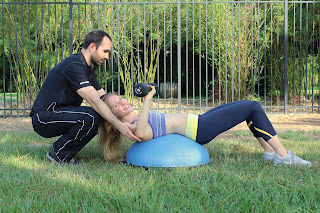What could be healthier than a salad? Quite a few things, actually, depending on what's thrown into it. A salad can start off as perfectly wholesome but easily turn into a healthy meal gone wrong, costing you hundreds, even thousands of calories. This concept might be hard to wrap your mind around, which is why I've provided a couple of prime examples.
Take California Pizza Kitchen's Moroccan Chicken Salad for instance. Being comprised of butternut squash, dates, avocado, almonds, beets, eggs, cranberries, and a vinaigrette dressing, you would expect this to be a great lunch or dinner choice, would you not? If you take into account that a full-sized portion contains 1,370 calories, 12 grams of saturated fat, 1,040 milligrams of sodium, and
116 grams of carbohydrates, you might reconsider. Then there's IHOP's Chicken and Spinach Salad. Based on its name, you might wonder what could possibly be wrong with this one. After all, chicken and spinach are plenty good for you! Well, the chicken is fried, and the additions of bacon and cheddar cheese bring this salad up to 1,530 calories, 111 grams of fat (30 of which are saturated), and 2,400 milligrams of sodium. For other seemingly healthy salads to look out for along with some healthier alternatives, check out
Eat This, Not That's list of
7 Salads You Should Never Eat!
It's not always what's put in the salad that raises the calorie count though. In many cases, you may have a flawlessly nutritious salad in front of you, but upon pouring on the salad dressing (as many restaurants do), the calorie, sugar, fat, and sodium content can escalate to alarming numbers. Some of the worst dressing culprits may be easier to pick out, such as
Ken's Buttermilk Ranch, while others may appear to be amongst the healthiest, such as
Girard's Light Champagne. Don't let words such as "low-fat" and "light" fool you
— it always pays off to read the nutrition facts on the back of the packaging.
So, does this mean you have to nix you favorite salad dressings? Not at all! To keep the numbers down, ask your waiter for your dressing on the side. Instead of pouring it on yourself, dip your fork into the dressing and lightly coat it before going into the salad and taking a bite; you'd be surprised by how little you need to obtain the flavor! I always find myself with about 2/3 the amount of dressing left over when using this trick. If fork dipping isn't your thing, you could always opt for a healthier dressing altogether. Balsamic vinegar, vinaigrettes (most, not all), oil and vinegar, and lemon or lime juice are safe choices (think clear, not creamy), or you could always make your own.
FitSugar provides some great dressing recipes you can view by clicking the link
here!
If you're preparing a salad from scratch at home or at the salad bar and are worried about creating an unhealthy concoction, check out this incredibly helpful
Build Your Own Salad tool from
Women's Health Magazine. It not only provides you with the nutritional info of your personalized salad, but also offers a
list of salads pre-approved by the mag. Salads are nothing to fear, just be mindful of what's going in to keep them healthy!
 True to form, I did make a mistake while baking them, being that I made the cookies larger than I believe they were intended to be. This, like my last baking venture, resulted in a significantly increased cooking time. After adding on additional time, the cookies were still very, very soft. I worried they would fall apart even after cooling and should have kept them baking longer, but the incredible aroma wafting out from the oven was tantalizingly good. My mom and I simply couldn't wait any longer, so I acted on impulse and pulled them out of the oven before we felt they were ready.
True to form, I did make a mistake while baking them, being that I made the cookies larger than I believe they were intended to be. This, like my last baking venture, resulted in a significantly increased cooking time. After adding on additional time, the cookies were still very, very soft. I worried they would fall apart even after cooling and should have kept them baking longer, but the incredible aroma wafting out from the oven was tantalizingly good. My mom and I simply couldn't wait any longer, so I acted on impulse and pulled them out of the oven before we felt they were ready.











